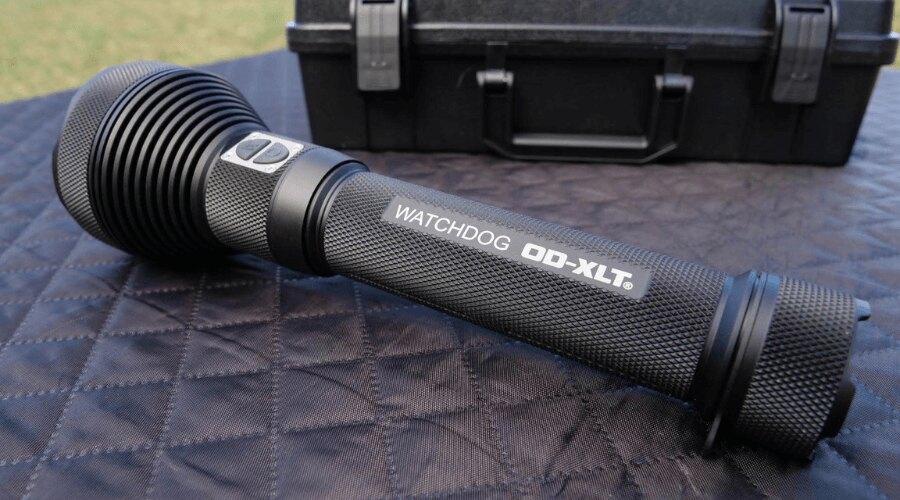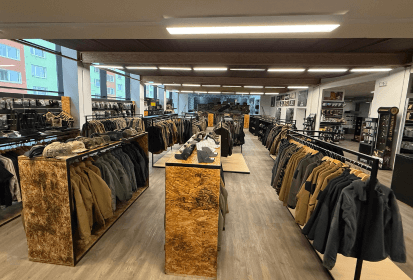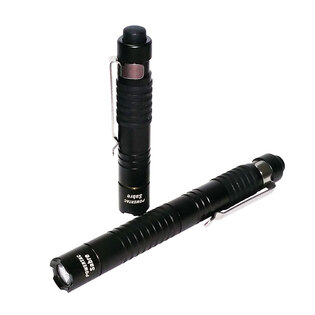Light up your way: about flashlights from A to Z
Light is the absolute basis for the success of any night event. And since it really isn't possible without proper light, a good flashlight is one of the key elements of outdoor equipment. With the current boom in headlamps, it could sometimes seem that hand torches are starting to play second fiddle. However, this is not true. Hand-held flashlights reliably cover a wide range of activities, and in addition, even in this field we encounter more and more powerful and sophisticated models. Light up your journey with us!
What is a hand flashlight for…
…when I can have a headlamp that frees up my hands? The answer is quite simple. Large and powerful hand torches usually have a larger capacity for batteries or accumulators. They can therefore have significantly greater performance and endurance. They also tend to be significantly more durable than headlamps and offer higher levels of protection.
Smaller models, e.g. the pocket ones, are suitable in situations in which you do not need to put on a headlamp (for example, when you shine your light when unlocking the door in the evening). In short, everything has its pros and cons.

Large hand torches can have a much higher output and a longer beam distance than headlamps and thus cover a different spectrum of tasks. The Watchdog OD-XLT PowerTac flashlight boasts a beam distance of over 1 km.
Where and how will I use the flashlight?
Before you start choosing a specific model, it is a good idea to first clarify for what purposes you will use the flashlight and what you expect from it. It's basically the same as when choosing any other outdoor gear.
- If, for example, you are looking for a model for professional rescue operations, night searches, etc., you will be looking for a reliable and durable flashlight with high performance and a large beam distance. However, such a lamp will be quite heavy and part of the energy may be used to cool the system, so they may have a slightly shorter lighting time.
- At outdoor events, low weight, a certain degree of resistance to water and dirt, and the (in)ability to recharge the battery in the field will play a role for you. Also be careful in cold areas, where there is a risk that the battery will discharge faster (similar to a smartphone battery). Maybe you'll end up sticking with a headlamp and supplementing it with a portable camping light for added convenience.
- A flashlight for tactical purposes must have "lumens", i.e. a high power mode. A very strong light (over 1,000 lm) can function as a tactical element or directly as a weapon. Additional lighting modes such as strobe or color modes are an advantage. Furthermore, the tactical flashlight must be durable and reliable, easy to operate and must allow a stable grip under all circumstances (e.g. thanks to a special surface treatment). Choose a size that is suitable for carrying in a pocket, bag or pouch on a belt or vest.
- You will appreciate the color modes of the flashlight for hunters (and not only for them). While white light is used for general lighting, colored modes are better suited for hunting activities, as many animals do not perceive colored light. This way, you have the opportunity to facilitate tracking and get closer to the game. Resistance to rain or falling from a height will also come in handy.

Flashlights with different characteristics are suitable for different types of tasks. The PowerTac Pathfinder flashlight is ideal for rescue and search operations, when it is necessary to intensively illuminate large areas.
Light sources
LEDs
Among the most common light sources today are LEDs (Light-Emitting Diode). Their main advantage is a low purchase price and high performance; if more LEDs are used, the total performance can be increased even more. In tactical and outdoor flashlights, you will often come across the term CREE LED. CREE is an American manufacturer of high-brightness LED chips and is known for its innovative approach. Modern Luxeon LEDs also have high performance, but their disadvantage is a higher purchase price.
Xenon
Also a fairly commonly used resource. The xenon bulb has a high output, its disadvantage is lower mechanical resistance. Some manufacturers combine xenon light sources with LEDs for greater versatility, but this reduces the optical quality of the resulting beam.
Halogen
Halogen lights are less common these days and you'll find them more often in larger lamps with lower power.

Among the most common light sources today are LEDs (Light-Emitting Diode).
Lighting
Luminous flux
Now we get to those ever-tossed lumens. So how are they? Lumen is a unit of luminous flux or brightness of light. Basically, the more lumens, the brighter it is. But how many lumens are enough lumens?
Again, the optimal number of lumens varies depending on what you will be using the flashlight for:
- For lighting a tent or cabin, a weaker light in the order of tens of lumens will be ideal. You can also use this mode for long-term lighting.
- For normal activities (e.g. illuminating the road) and night outdoors, the optimal mode with a luminous flux in the order of hundreds of lumens.
- For tactical purposes or search operations, on the other hand, you will need intense light in the order of thousands of lumens.
Lighting modes
Most flashlights have several lighting modes with different intensities. However, this also goes hand in hand with endurance (lighting time), which can also vary significantly between different models. A weak "ignis fatuus" with a luminous flux of 7 lm can last you several days at a time, while an intense light with 1,000 or more lm can last for just a few hours. The SOS and strobe modes also usually light at maximum intensity, lasting only a little longer than the constant mode at maximum light intensity.
Color modes
In addition to the standard white light, many flashlights are also available in red, possibly also green and blue.
- Red light: less glare and can be seen at a shorter distance. So you use it when you don't want to disturb the surroundings too much or be seen. Some animals, especially predators, cannot see red light, so it is also suitable for hunters.
- Green light: suitable for movement in fog, rain or snow and better renders distant objects. It is used when hunting certain types of game, e.g. wild pigs.
- Blue light: is pleasing to the eye and most effective for lighting in fog. It helps in identifying blood stains. Blue light is also ideal for map reading.

Color modes are an advantage in many ways. Red light is less dazzling and can be seen at a shorter distance.
Power supply
Battery
Flashlights most often use lead-acid batteries (AA), micro-lead (AAA), which are slowly being phased out at the moment, or lithium batteries. They are characterized by better durability, a long service life and relatively high resistance to external temperatures (they can be used even at extremely low temperatures).
Accumulator
An alternative and at the same time a hit of modern times is the rechargeable Li-ion battery type 18650 built directly into the flashlight. These are usually available in capacities from 2,300 to 3,600 mAh (if the manufacturer indicates a noticeably higher number, it is probably a fake). Accumulators with direct charging via a USB cable are also available.

Some modern flashlights have a built-in rechargeable battery. The PowerTac Watchdog OD-XLT flashlight has a practical magnetic connector.
Design
Material
Modern flashlights are most often made of aluminum alloys, which are light and durable.
Surface finish
When choosing, also pay attention to the surface treatment of the lamp. Serrations, groovings or e.g. rubber finishes make it easier to grip and ensure that the flashlight does not slip in your hand.
Degrees of protection
For demanding conditions, water protection in the range of IPX4 (against splashing water) and IPX8 (waterproof – against continuous immersion in water) will be ideal.
Accessories
Flashlights can contain other practical functional elements, such as:
- a crowned bezel that protects the reflector,
- metal clip for hanging in a pocket or on a belt,
- charge status light,
- case or strap, etc.
Rigad recommends
PowerTac® Pathfinder handheld flashlight
This is where we start off really sharp. The PowerTac Pathfinder flashlight is worth a closer look. It is designed to withstand demanding search and rescue operations, when you need to intensively illuminate a wide area.
You may be surprised by the higher weight, shorter lighting time and higher purchase price of this flashlight. But it offers a lot in return. Above all, it is a respectable luminous flux, which in the highest lighting mode reaches 12,000 lumens, and a maximum beam distance of around 470 m. There are a total of 3 lighting intensities available (low – 670 lm, medium – 4,300 lm, high – 12,000 lm), SOS and strobe mode, and then 4 color modes: white, red, blue and green.

The PowerTac Pathfinder comes in a Peli-style resistant carrying case and a belt pouch, charger and spare seal are included.
The construction of the flashlight made of aircraft-grade aluminum is robust, compact and very durable. It has an IPX6 degree of protection, so it can withstand even heavy rain. The crowned bezel protects the glass against damage and can also be used, for example, for self-defense. The strongly serrated surface treatment ensures a stable grip. Buttons for simple and intuitive operation can be found on the side, while in the back there is an input for a charger and a USB output, so the flashlight can also function as a power bank, e.g. to charge a phone.
The packaging is also luxurious. You will receive the flashlight in a resistant carrying case along with a nylon belt pouch, charger and spare seal.
PowerTac® Watchdog OD-XLT
We'll stop by PowerTac for a moment. This "watchdog" is worth paying attention to thanks to the maximum beam distance of over 1,000 m. What else can it do?
The Watchdog flashlight offers a total of 6 light modes including SOS and strobe. In the basic mode of 10 lm, it lasts for up to 14 days, while in the turbo mode of 2,300 lm (with a beam distance of 1 km) it lasts for about 3 hours. In SOS and strobe modes, it will shine for up to 6 hours at maximum power. Furthermore, 4 color modes are available: white, red, blue and green.

The surface treatment of the PowerTac Watchdog OD-XLT flashlight ensures a stable grip.
The construction is made of aircraft-grade aluminium and the heavily serrated finish ensures a stable grip. The flashlight is waterproof according to IPX7 degree of protection. Charging with a magnetic connector is also a good feature. The package includes a resistant case, a charger and a practical strap with stainless steel rings, thanks to which you can comfortably carry the flashlight over your shoulder.
NexTorch® TA30 Max
We will now move from large flashlights to pocket ones. This model is interesting in many ways. Its aluminium construction is light, easy to store and compact, while it is precisely processed and holds everything absolutely firmly in place. The flashlight has an IPX8 degree of protection, i.e. against continuous immersion in water. The matte finish does not reflect any unwanted reflections. Thanks to the texture on the surface, the flashlight holds well in the hand and does not slip, no matter which way you hold it. The crowned bezel that protects the reflector has ceramic beads around the perimeter for breaking glass or self-defense.
Also interesting is the rechargeable Li-ion battery 21700, which is charged directly via the integrated USB-C and includes a charge status indicator. A bit unconventional, but still practical, it is controlled using a wheel located at the back and a thumb button. The flashlight has a total of 5 modes: tactical, strobe and 3 light intensities, with the basic mode having 70 lm and lasting for 23 hours, while in the maximum mode it reaches 2,100 lm for 2.5 hours.
PowerTac® Sabre Pen
This mini LED pencil flashlight is actually two flashlights in one. How is it possible? We'll get to that soon. But first, let's introduce it briefly...
The Sabre Pen flashlight is made of aircraft aluminium, has an anodized surface with anti-slip treatment and a crowned bezel that protects the reflector. The length of the lamp is 12 cm and the diameter is 1.5 cm. The practical steel belt clip is removable. You will receive this flashlight in a case filled with softened foam in a set with a key ring and a spare seal.

The PowerTac Sabre Pen flashlight comes in a transparent case filled with softened foam.
A total of 3 lighting modes are available: low (239 lm, lasts approximately 1 hour), medium (77 lm, lasts 2.5 hours) and strobe (239 lm, 1.5 hours). It is operated by a simple thumb switch at the end side. The flashlight also has a memory and will always light up in the mode in which it was last used.
Now to the question of why this flashlight is 2 in 1. As standard, it uses 2 AAA batteries (which are not included in the package, but can be easily obtained). If you only have one battery, you only need to disassemble the flashlight about halfway, screw the reflector to the back, and in no time you will get a smaller flashlight for one AAA battery, only with a slightly lower power and a shorter lighting time.
Readers are further interested












































































































































